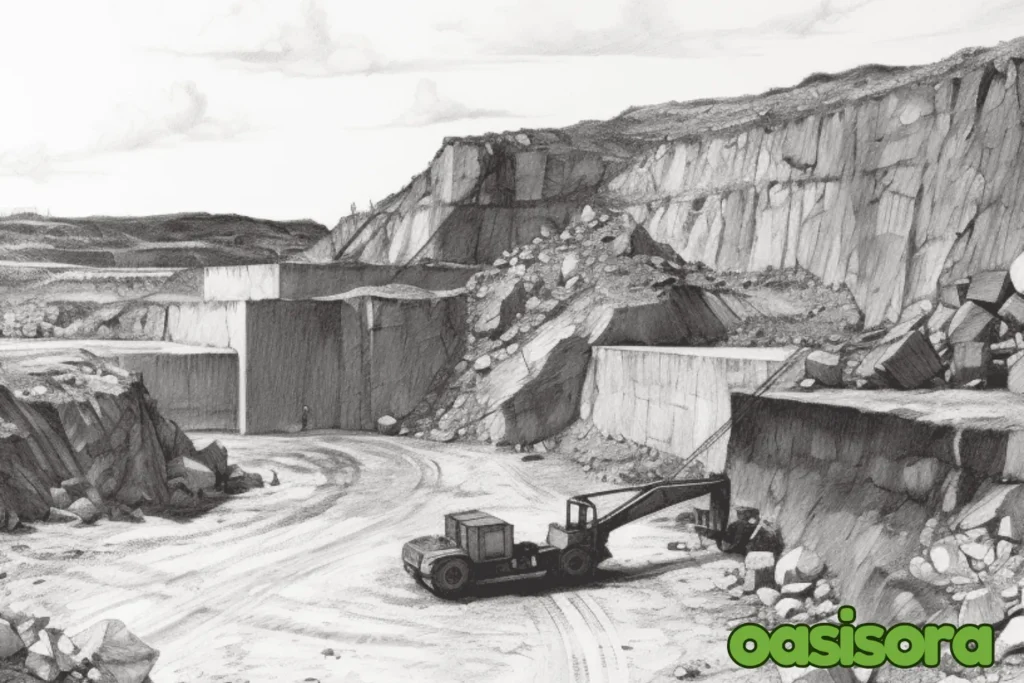
Choosing the right gravel for your fire pit seating area isn’t just about looks it’s about safety, comfort, and durability. The best gravel offers a stable, fire-safe surface that enhances both function and style. But with countless types, textures, and sizes, selecting the best gravel for fire pit seating area is too daunting. That’s why we provide a practical guide to help you make informed decisions for your unique landscaping projects.
This guide will cover all the options for the best gravel for fire pit seating areas. So, get ready to Cozy Up your outdoor space!
TL; DR
- Soft gravel (like pea gravel) is perfect for bare feet but doesn’t pack down well. Use it in quiet areas with fixed furniture and little foot traffic.
- Textured gravel and crushed stone are sturdy but locked together more easily, making a stable and level surface when compacted. Perfect for busy areas with Movable fire pit chairs and furniture.
- For eco-friendly landscaping, consider crushed brick, recycled glass, or crushed shells. These sustainable alternatives offer environmental benefits, although local availability may vary. They are perfect for those seeking green options without sacrificing style or functionality.
Choosing the Best Gravel for Your Fire Pit Seating Area
Have you recently bought a new fire pit or built your own from scratch? Then, explore my top gravel picks and alternative options for picking the best gravel for fire pit seating area for a safe and stylish outdoor oasis.
Determine the Size and Shape of the Seating Area
The very First thing before choosing the best gravel for fire pit seating area is to decide on the size and shape of your seating area. This affects how the space of your seating area is used.
You can consider how many people will use it and what furniture to include. Plus, think about activities like reading, eating, or socializing. Next, you can measure the space and choose a shape that fits.
A rectangular shape works for long spaces, while square or circular shapes suit smaller areas. Leave the room for people to move around and enjoy.
Folks! Have you thought about how the size and shape of your sitting area can change how it feels? A small space can be cozy, while a larger area can fit more people.
So, it’s absolutely up to your own will and desire!. By planning carefully, you can create a functional and enjoyable space. This helps you make the most of your outdoor area.
1. Pick Your Gravel
1. Pea Gravel
Pea gravel is affordable, comes in many colors and sizes, and works well for fire pits. As the name suggests, Pea gravel has tiny, rounded stones. Its gentle texture is perfect for bare feet and pet-friendly spaces.
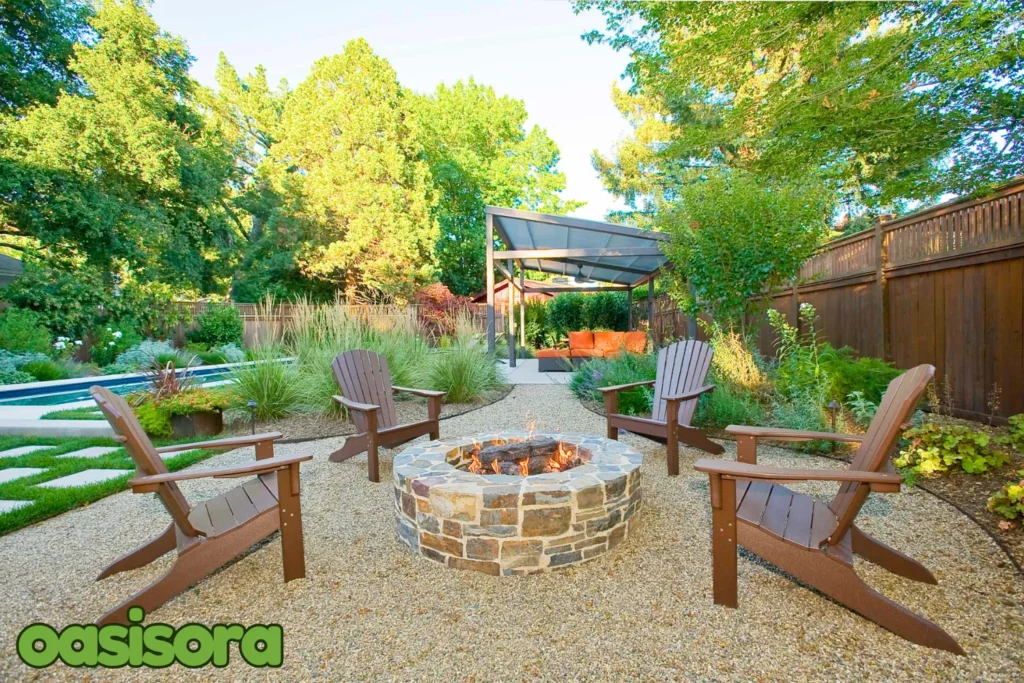
Pea Gravel
However, Pea gravel’s smoothness has a downside: it’s hard to pack down firmly. This means it can shift easily, making it less ideal for areas with movable furniture or lots of foot traffic.
Use pea gravel in low-traffic areas around your fire pit, such as those with permanent outdoor furniture like Muskoka chairs.
| Pros: | Cons: |
| Ergonomic: ( Gentle on feet and joints and comfortable to walk on) | Maintenance: (Requires frequent caring and replacement) |
| Versatile: ( Multiple color options to match your style) | Furniture Limitations: ( Not compatible with narrow-legged furniture) |
| Drainage: ( Excellent drainage capabilities) | Accessibility: ( Not wheelchair or stroller-friendly) |
2. Crushed Granite
Granite is a strong, natural rock with unique beauty and varied colors. It’s perfect for many landscape styles. Crushed granite gravel has a unique texture, with minimal sharp edges.
When compacted, it locks together, forming a stable surface. Over time, crushed granite decomposes, softening edges and forming a durable, even surface ideal for walking paths and outdoor furniture.
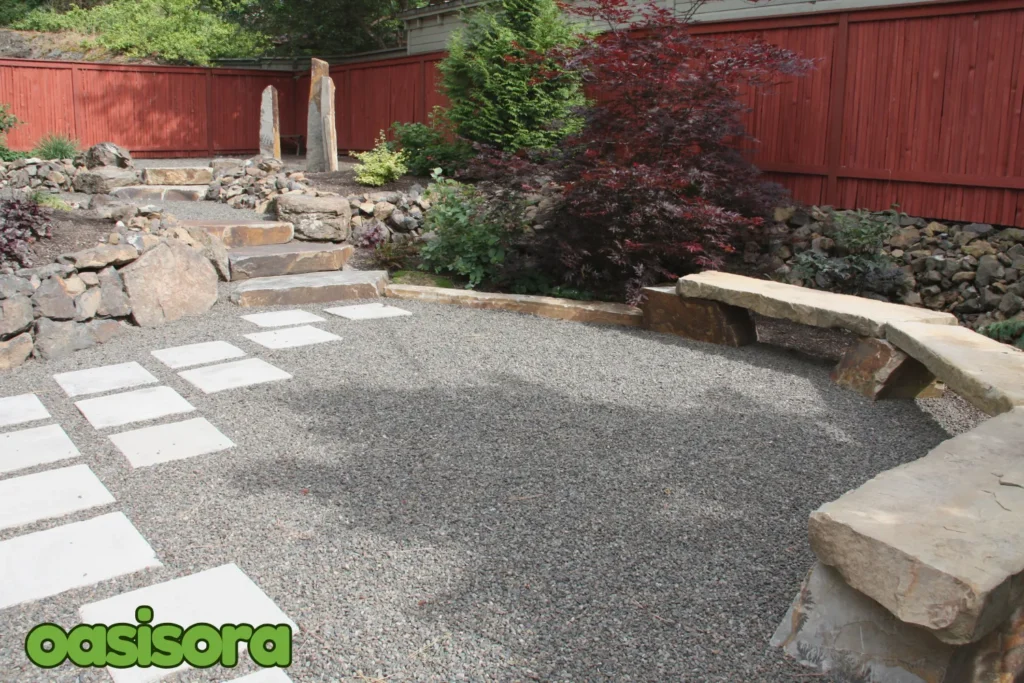
Crushed Granite
However, crushed granite gravel has a downside. It breaks down over time, becoming prone to settling and erosion.
Expect to replenish your gravel fire pit area with fresh crushed stone every few years.
Below are some perks of crushed granite that you should be aware of:
| Pros: | Cons: |
| Accessibility: ( Easily found at most hardware stores) | Initial Sharp Edges: (May require additional smoothing due to sharp edges) |
| Affordability: ( Cost-effective option for landscaping) | Stability Issues: (Not ideal for wheelchairs, strollers, or heavy foot traffic) |
| Versatility: ( Suitable for driveways, pathways, and fire pit areas) | Maintenance Needs: ( Prone to settling and erosion over time) |
3. Decomposed Granite
According to me, decomposed granite is one of the best gravel for fire pit seating areas. It offers a unique combination of style, durability, and practicality.
That makes it an ideal material for creating attractive outdoor spaces. It compacts to a stable, permeable surface, perfect for casual seating and foot traffic.
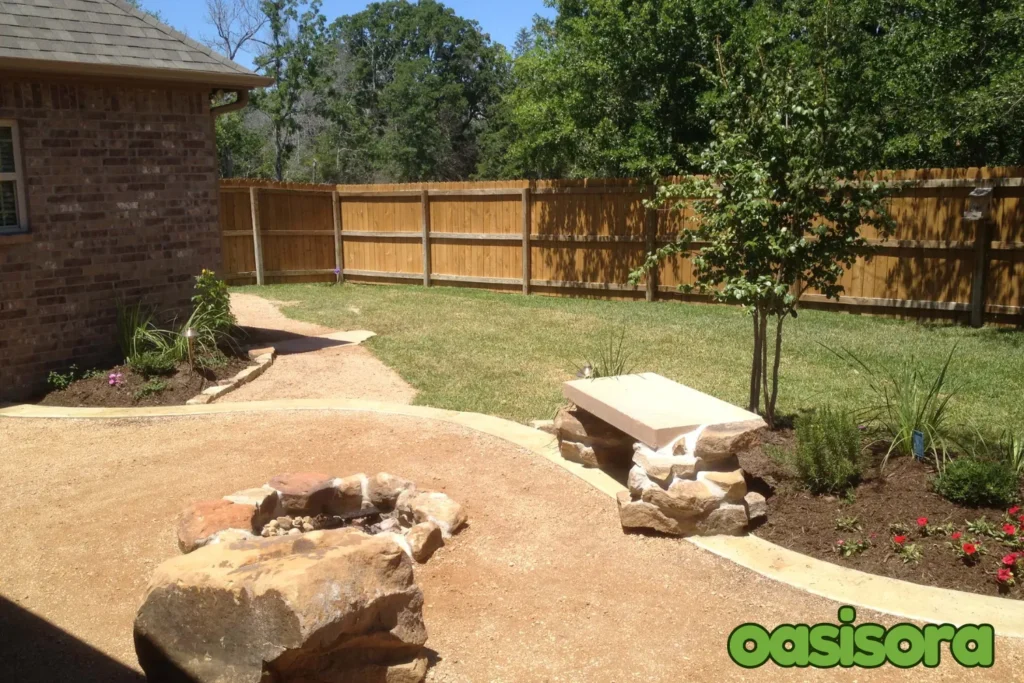
Decomposed Granite
But you should keep these two things in mind if you are picking decomposed granite:
- It can break apart over time if not installed correctly.
- It holds onto water, which can lead to unwanted moss and weeds.
To get the most out of your decomposed granite, ensure thorough compaction during installation and consider adding a border to contain the material
. This helps prevent destabilization and erosion, which often start at the edges of compacted gravel areas, maintaining its stunning appearance and extending its lifespan.
Decomposed granite can offer you these perks & Disadventages:
| Pros: | Cons: |
| Durability: ( Compacts well for a stable surface) | Maintenance: ( Gets muddy when wet, and dusty when dry) |
| Style: (Natural colors for an understated look) | Stability Issue: (Erodes if not sufficiently compacted) |
| Value: ( Relatively affordable and widely available) | Moisture Retention: ( Retains moisture in wetter climates, leading to weed growth – easily mitigated with proper installation and landscaping fabric) |
4. Basalt Chip
Basalt chips, also known as lava rock, can add a dramatic touch to your outdoor fire pits. This dark, volcanic rock is readily available in various sizes:
- 1/4″ chips for decorative ground cover
- Medium-sized stones for accentuating fire pit surrounds
- Large cobbles for statement landscape features
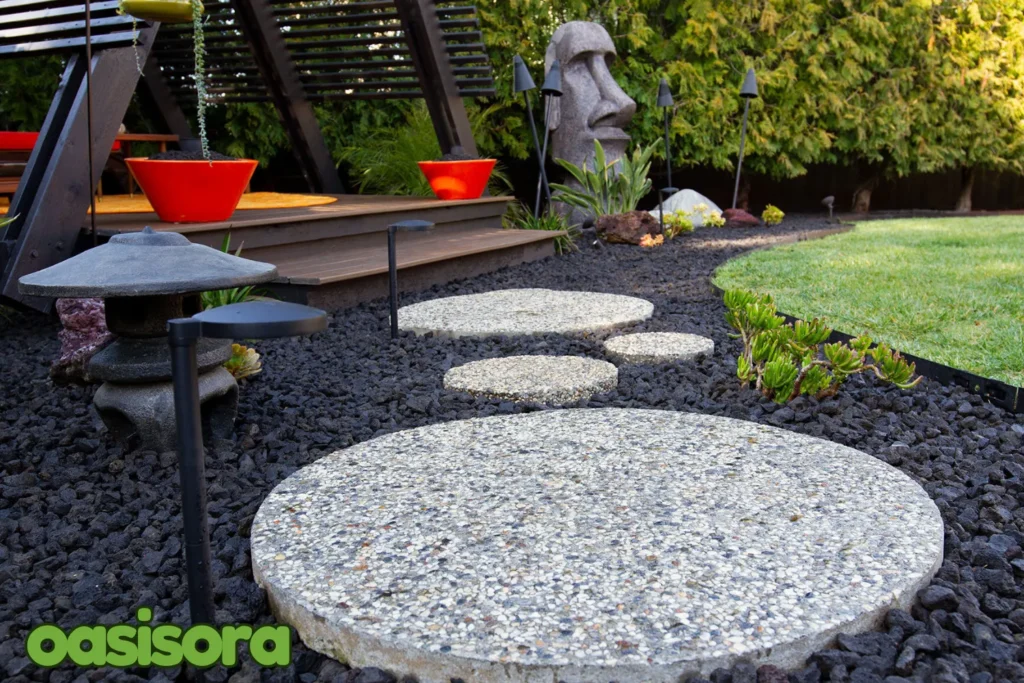
Basalt Chip
Basalt chip’s natural binding and compactable properties ensure a stable and long-lasting surface, while its porous nature prevents water accumulation and erosion.
Basalt chips’ dark color creates a dramatic contrast with plants and lighter materials but also absorbs heat.
This means rapid snow and ice melt in winter, yet potentially scorching surfaces in summer, requiring careful planning for shade and maintenance.
The Basalt chips, being lighter and more brittle, are prone to displacement and erosion. Think about replenishing your fire pit area with fresh basalt chips every few years to maintain its appearance.
Discover the amazing benefits and drawbacks of the Basalt chip:
| Pros: | Cons: |
| Stability: ( Compacts well for a durable surface) | Stability Issue: ( Easily displaced if not sufficiently compacted) |
| Aesthetic Appeal: ( Dark color creates a striking landscape) | Comfort: ( Uncomfortable for walking barefoot) |
| Drainage: ( Decent water drainage properties) | Cost: ( Price varies depending on regional availability) |
5. River Rock
My other top pick for best gravel for fire pit seating area is River Rock. A River rock (or river jack) is a smooth, large gravel ranging from golf ball to softball size, ideal for decorative landscaping and water features.
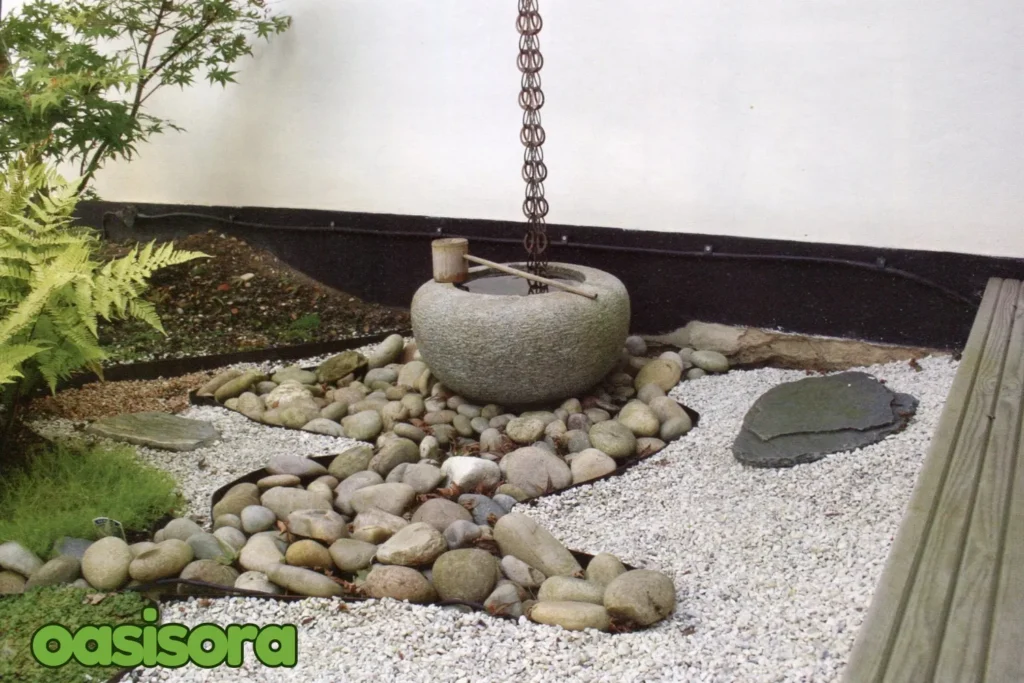
River Rock
As its name implies, river rock usually comes from riverbed deposits. The river’s flowing water smoothes the stones over time, creating river rock’s characteristic smooth surface.
River rock is best used as a decorative accent for borders and edging due to its large size. It’s not suitable for walking surfaces or furniture placement, as it’s uneven and challenging to walk on.
Here are the adventages and drawbacks of the river rock:
| Pros: | Cons: |
| Durability: River rock withstands harsh climates and is durable) | Walking Difficulty: (Uncomfortable surface for walking or standing) |
| Decorative Edge: ( Perfect for beautiful borders and edging) | Higher Cost: ( Pricier than other gravel options) |
| Easy Care: (Requires minimal upkeep and maintenance) | Installation Challenges: ( Heavy weight makes installation more difficult) |
6. Crushed Limestone
Crushed limestone is a dependable gravel choice for landscaping and construction. It serves as a sturdy base for walkways, driveways, and gravel roads, and is also used in patio and retaining wall construction.
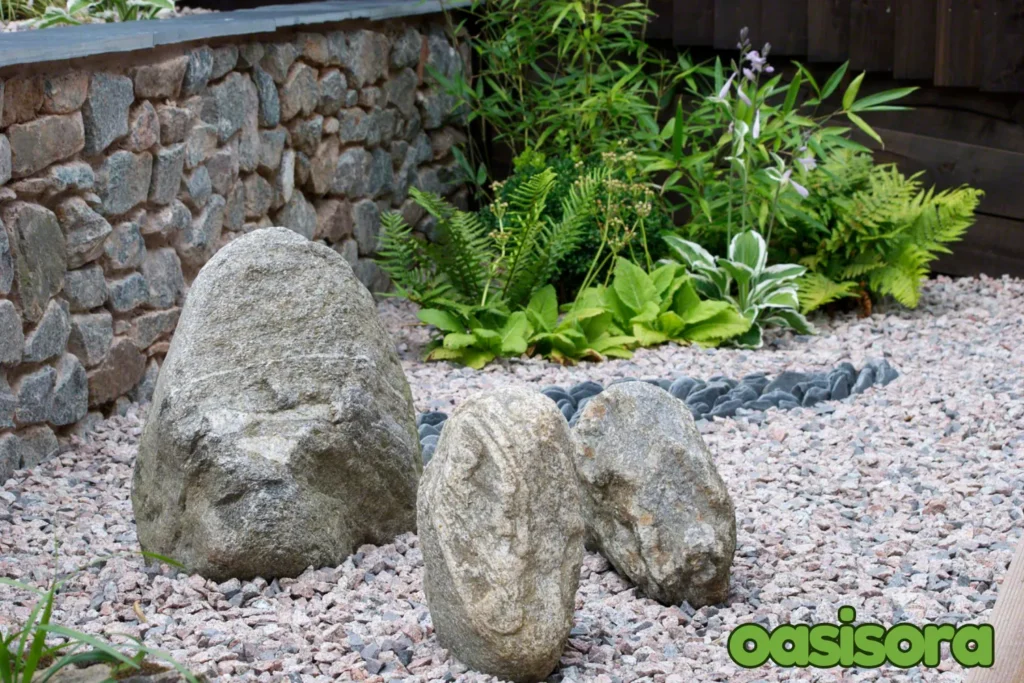
Crushed Limestone
Crushed limestone’s classic look and practical benefits make it the best gravel for fire pit seating areas.
Its textured, larger grains provide stability for outdoor furniture, while its drainage properties ensure a safe and dry gathering space.
Note: Avoid installing crushed limestone directly within or next to DIY fire pit rings/kits.
Because when it comes into contact with high temperatures or open flames, it can provide a real explosion risk.
You can get the following advantages and disadventages by using crushed limestone as gravel:
| Pros: | Cons: |
| Affordability: (An inexpensive option for landscaping areas) | Soil pH Disruption: ( Plain Alkaline can alter the pH of the surrounding soil) |
| Functionality: (Stable surface for foot traffic and heavy furniture) | Explosion Risk: Explosion hazard near open flames, avoid fire pit placement. |
| Drainage: (Excellent water drainage) |
2. The Difference Between Gravel and Crushed Stone
Although both gravel and crushed stone have different origins, shapes, and uses both are considered main building and landscaping materials.
Gravel and rocks used in Zen gardens, shaped by water erosion, often have rounded, smooth edges. Natural gravel from rivers and beaches is ideal for gardens and pathways, providing excellent drainage while adding aesthetic appeal.
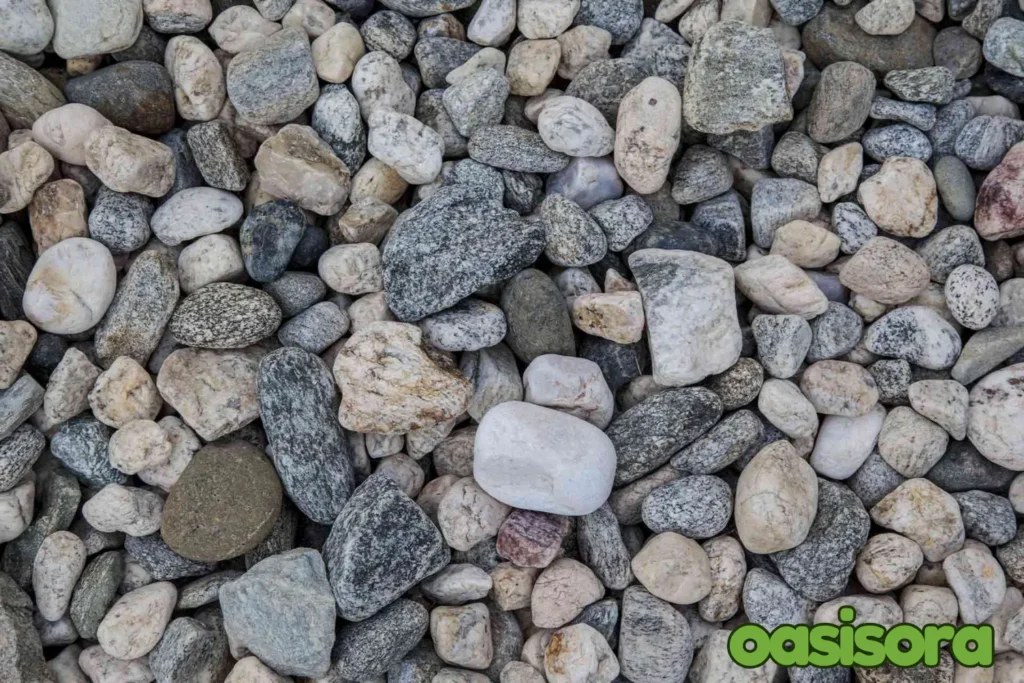
Gravel
Crushed stone, made from broken rocks, has sharp edges and comes in many colors and textures. When compacted, it’s sturdy enough for roads, foundations, and railroads.
The choice between gravel and crushed stone depends on your project’s requirements. Gravel is best for drainage and comfort, but requires more upkeep.
Crushed stone offers stability and durability, making it perfect for high-traffic areas and construction projects.
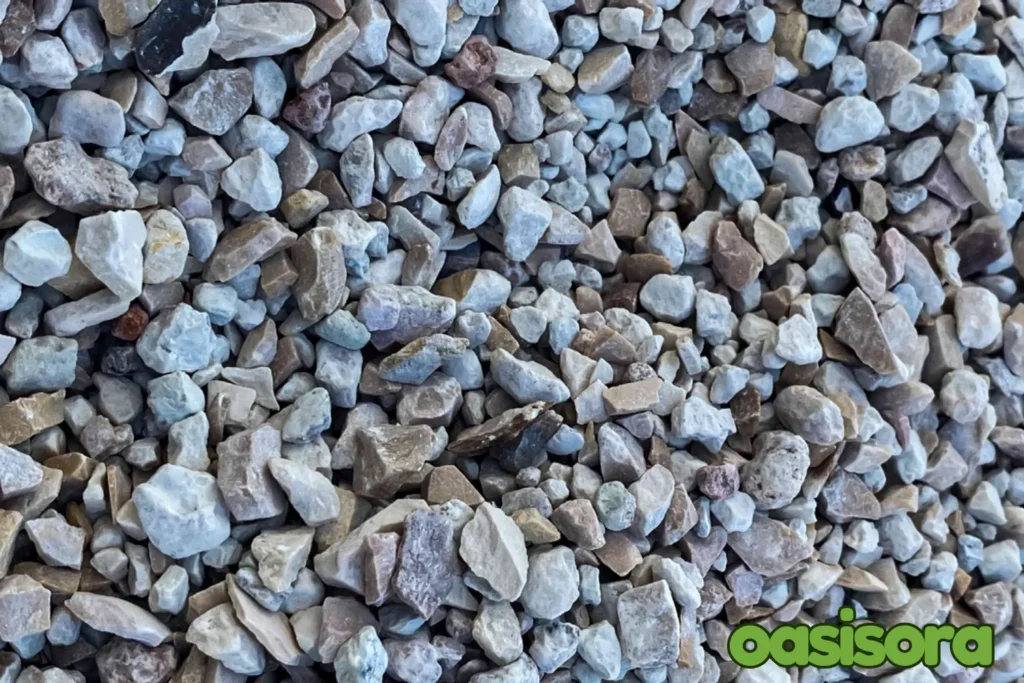
Crushed Stone
Crushed stone’s rough texture makes it less comfortable underfoot, but its durability suits structural applications with heavy loads.
Gravel, softer and better for drainage, is ideal for gardens and pathways. Both materials are cost-effective, with prices influenced by local availability and source distance.
How Gravel Affects the Seating Area’s Comfort and Durability
Gravel affects your seating area’s comfort and durability. The type you choose matters. Smaller or smoother gravel is too cozy and comfortable to walk on, while jagged or huge gravel isn’t.
Plus, Gravel also impacts durability. Some types shift or erode, causing uneven surfaces and tripping hazards. Others are durable and withstand heavy foot traffic, helping with drainage and preventing water accumulation.
Consider your own comfort and durability when choosing gravel. fihuerneitjjwhich type will be most appropriate for the area and your planned implementation.
You can design a beautiful, long-lasting, and excellent seating area and will be able to enjoy your outside oasis for many years to come by using the best gravel for fire pit seating area…
3. Why Texture Is Important
When selecting the best gravel for fire pit seating area, texture is a vital factor to consider. Different textures serve distinct purposes, including safety, stability, and visual appeal.
Pea gravel and other smoother gravels are ideal for locations where safety and comfort are top priorities. Their rounded edges provide:
- Comfortable walking surface, ideal for bare feet or playful areas
- Reduced risk of cuts and scrapes
- Enhanced safety around fire pits
Because of its soft texture, pea gravel is a great option for fire pit settings, ensuring a fun and safe experience.
On the other hand, Crushed granite is perfect for high-traffic outdoor areas, offering superior stability, durability, and resistance to shifting and settling.
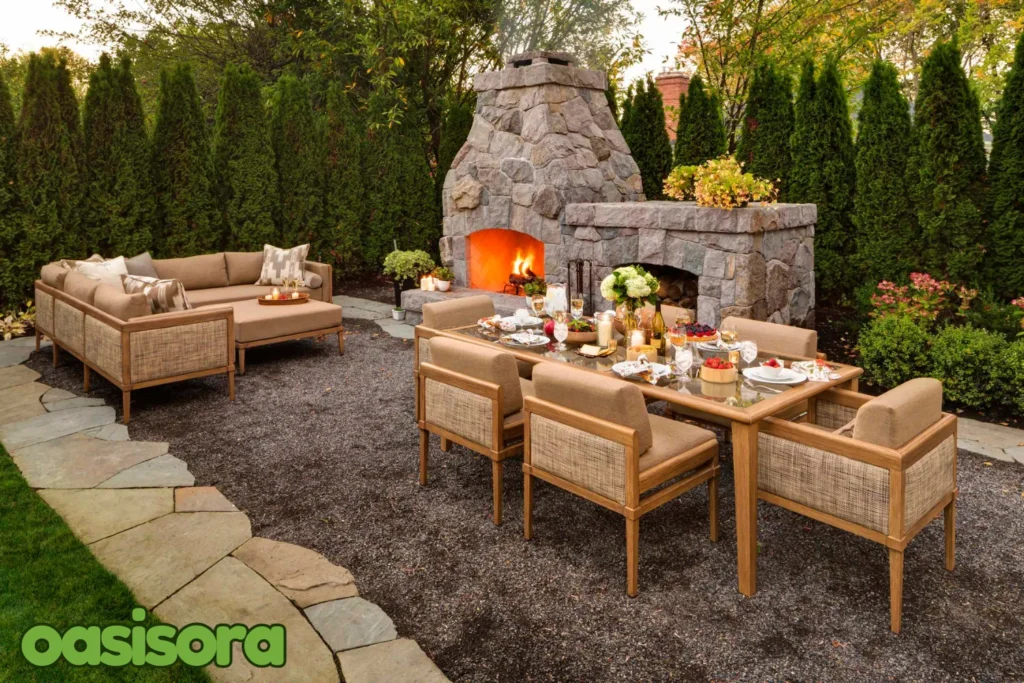
Texture of Gravel for fire pit seating area
Choosing the best gravel for fire pit seating area depends on its use and maintenance needs. Smooth gravel requires more upkeep, while angular gravel is durable and low-maintenance. Balance functionality and aesthetics to make the perfect choice.
4. Popular Gravel Alternatives
Gravel and crushed stone are not your only choices for fire pit seating areas. Here are some other options I recommend:
7. Crushed Brick
Add elegance and sustainability to your fire pit seating area with crushed brick. It’s a sustainable and stylish choice.
Constructed from recycled materials, it adds a distinctive, rustic beauty while reducing waste and carbon emissions.
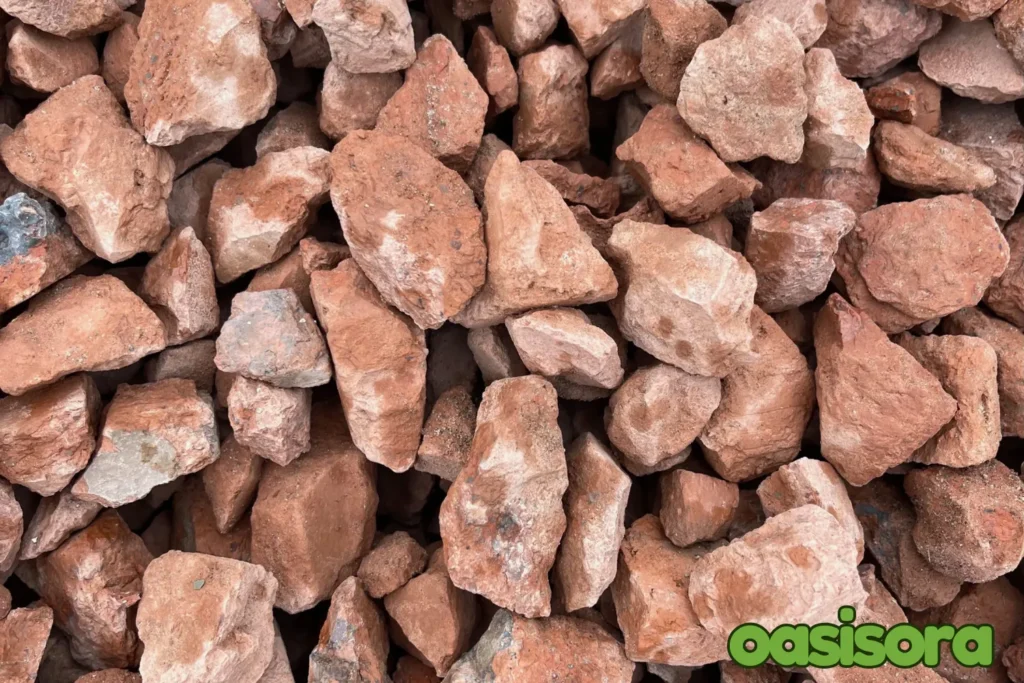
Crushed Brick
You can enhance your outdoor area with the rustic appeal of crushed brick and its bright red and yellow shades.
It’s sturdy for furniture and foot traffic but may be rough on bare feet and pets.
8. Recycled Glass
Recycled glass can add a touch of eco-chic charm to your landscape. Smoothed for safety, it’s available in various colors and sizes, offering style and sustainability. You can use them for your:
- Mulching
- Pathways
- Garden accents
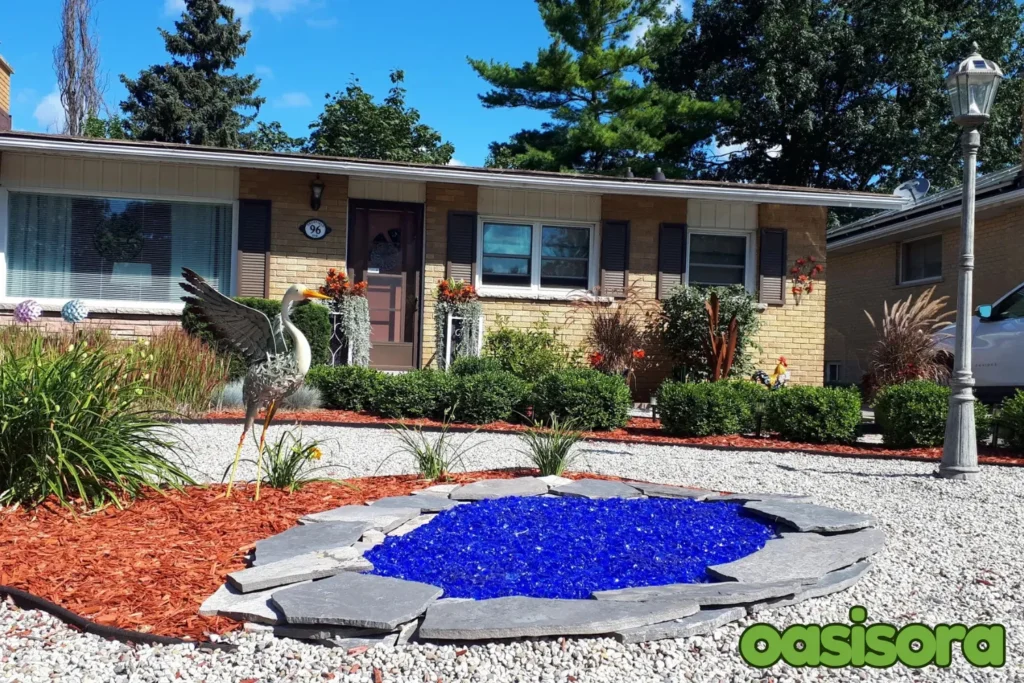
Recycled Glass
Recycled glass is a green landscaping option that helps reduce waste and lasts long. It’s safe for soil and doesn’t break down. However, it can be hard to find and costs more than traditional gravel or stone.
9. Crushed Shells
Imagine giving your outside area a little seaside charm! Crushed shells, such as those of scallops, clams, and oysters, can be used for that.
They are excellent substitutes for gravel in fire pit areas, mulch, and garden pathways. Plus, their natural white and cream hues will brighten up your garden, creating a clean and airy feel.
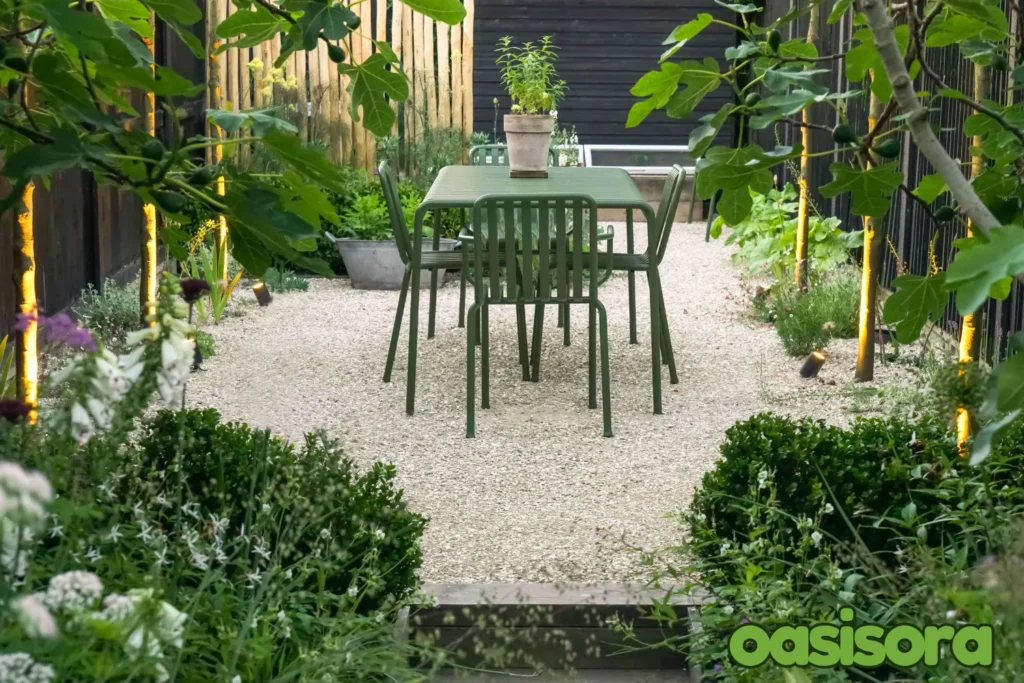
Crushed Shells
Crushed shells nourish your garden naturally. As they break down, they release vital nutrients in the soil and foster healthy plant growth. Also, these shells are made up of recycled seafood waste makes them an eco-friendly choice and offers these perks:
- Improved soil quality
- Reduced waterlogging
- Enhanced drainage.
Commonly used in coastal areas, they may be less available and pricier inland.
Note: they can make soil more alkaline, so choose plants wisely.
5. Factors to Consider When Choosing Gravel
When selecting the best gravel for fire pit seating area, consider these key factors for a functional, safe, and stylish space:
1. Safety
Some rocks can explode or crack near fire pits due to their makeup. Choose safe, heat-resistant rocks to avoid danger.
2. Comfort
When choosing gravel, consider comfort and stability. Smoother types like pea gravel are gentle on bare feet, while crushed stone provides a level surface for furniture.
3. Curb Appeal
Choose gravel that complements your home’s look, considering both daytime and nighttime appeal. Add some sparkle with string lights to elevate your space. Crushed stone and Gravel comes in two varieties:
- Washed
- Unwashed.
Unwashed is cheaper but contains dust and small particles. If possible, choose washed gravel or crushed stone for a cleaner, low-maintenance option that’s worth the extra cost.
4. Maintenance
To reduce weed growth in your gravel fire pit seating area, install a permeable landscape fabric underneath. Start by outlining your desired space with chalk or spray paint for easy installation. Then, lay down the fabric and gravel.
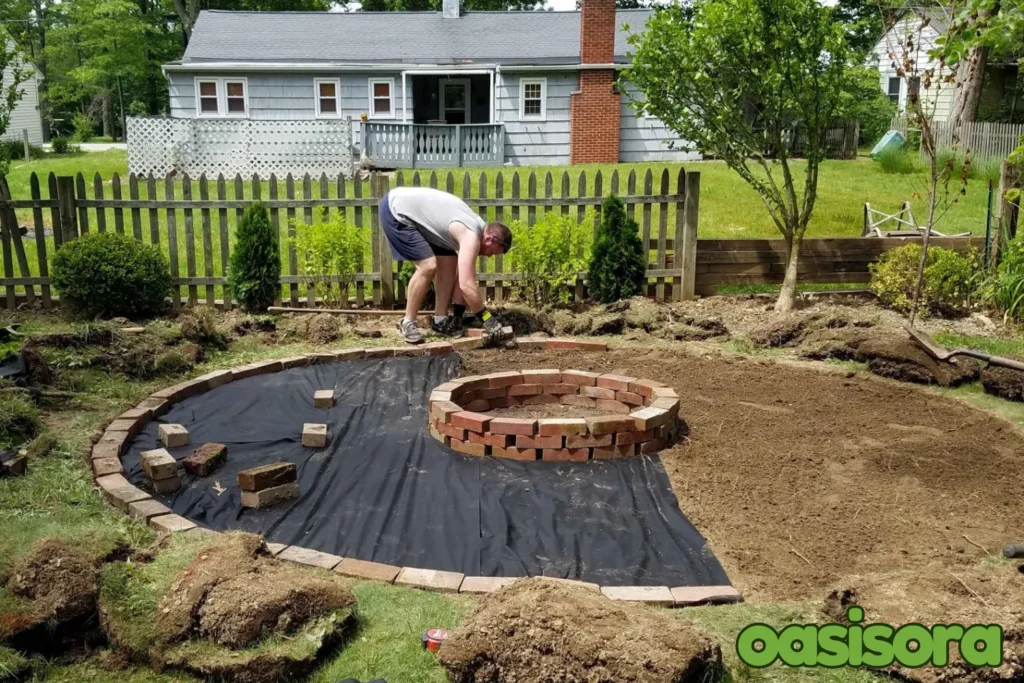
Maintenance of Fire pit area
To maintain loose gravel, like pea gravel, simply rake it regularly and top it up occasionally to keep it looking its best.
5. Durability
For outdoor areas, gravel is a durable alternative. It can survive in really severe weather and high foot traffic. Plus, when it is installed and maintained properly, it can last for many years. It’s a good deal for homeowners because of its longevity.
6. Drainage
Gravel helps keep your outdoor space dry by draining water effectively. Some types, like pea gravel, are especially good at preventing water buildup.
7. Environmental Impact
Choose local gravel to reduce your carbon footprint. Permeable materials like gravel also help the environment by reducing runoff and soil erosion.
8. Cost
When planning your Cost-effective fire pit landscaping, consider that gravel prices vary, so choose one that fits your budget. Don’t forget to factor in installation and ongoing maintenance costs to ensure your project stays affordable.
9. Accessibility
For easy wheelchair or stroller access to your backyard fire pit, choose a material that packs down flat and stable, especially for longer paths.
Enhancements for Your Gravel Fire Pit Area
After picking the best gravel for fire pit seating area, my dears! You can create a cozy and inviting space with these simple additions:
Adding Seating Options and Landscaping Features
Add patio benches or sofas for a cozy ambiance around your fire pit to create a nice ambiance around your fire pit. Or consider built-in seating, like stone or brick benches, for a more permanent solution.
Installing Edging and Borders for Defined Spaces
Install edging and borders to create a clear boundary. Use materials like brick, stone, or metal. This helps contain gravel and keeps your space organized.
Landscaping Features (optional)
According to me, a yard is incomplete without greenery! Add plants, shrubs, or trees for a natural ambiance. Plus, you can also include decorative elements like garden statues or water features to enhance the space.
Final Thoughts
Selecting the best gravel for fire pit seating area requires a mix of creativity and science.
Need Cozy feet friendly? Try Pea gravel.
Wants a Stable ground? Prefer Crushed granite.
Consider safety, comfort, maintenance, drainage, environmental impact, cost, and accessibility. From pea gravel to crushed stone, choose a heat-resistant option that suits your desires.
So, transform your outdoor space today into an attractive cozy oasis with the right gravel for your fire pit seating area.
FAQs
1. What stone should I use for a fire pit seating area?
If you want stability and heat resistance then you should utilize granite, limestone, or crushed brick for your fire pit seating area.
2. What kind of gravel to use around a fire pit?
Use heat-resistant gravel for a safe fire pit area, like:
Crushed Stone
Pea Gravel
Decomposed Granite
They withstand high heat and reduce fire risk.
3. What is the best material for a fire pit seating area?
You can select materials such as brick, crushed stone, or concrete for the seating area around your fire pit. They ensure safety and longevity.
4. What are the best stones for under a fire pit?
The best stones to use under fire pit are:
Granite
Fieldstone
Limestone.
5. What is the best thing to put under a fire pit?
Under a fire pit, crushed stone or sand can be used to ensure the safety and drainage of gravel.
6. What is a good bottom for a fire pit?
Pick a durable, heat-resistant bottom like concrete, brick, or stone for a fire pit. They ensure safety and durability.

4 thoughts on “9 Best Gravel for Fire Pit Seating Area in 2025”
Comments are closed.